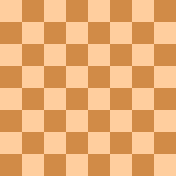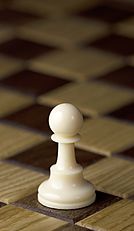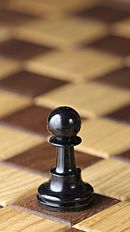Pawn (chess) facts for kids
The pawn (♙♟) is the smallest and weakest piece in the game of chess. Pawns are like the foot soldiers of your army on the chessboard. Each player starts a game with eight pawns. They are placed on the second row (or "rank") closest to you. For white, pawns start on squares a2 to h2. For black, they start on squares a7 to h7.
Contents
How Pawns Move
Pawns move in a special way that's different from other chess pieces. They are the only pieces that cannot move backward.
- Most of the time, a pawn moves forward just one square.
- But, for its very first move, a pawn can choose to move forward two squares instead of one.
- A pawn cannot jump over another piece, even when making its first two-square move.
- If there's any piece directly in front of a pawn, it cannot move forward at all.
When a pawn reaches the very last row on the other side of the board, it gets a special reward! It can be promoted to almost any other piece, like a queen, rook, bishop, or knight. Players usually choose a queen because it's the most powerful piece.
Capturing Other Pieces
| a | b | c | d | e | f | g | h | ||
| 8 |

|
8 | |||||||
| 7 | 7 | ||||||||
| 6 | 6 | ||||||||
| 5 | 5 | ||||||||
| 4 | 4 | ||||||||
| 3 | 3 | ||||||||
| 2 | 2 | ||||||||
| 1 | 1 | ||||||||
| a | b | c | d | e | f | g | h | ||
Unlike other pieces, pawns don't capture in the same way they move forward. A pawn captures pieces diagonally. It moves one square forward and either to the left or to the right.
Look at the diagram on the left. The white pawn at e4 can capture the black rook at d5 or the black knight at f5. It cannot capture the bishop at e5 because that piece is directly in front of it, blocking its path.
The Special En Passant Capture
En passant (pronounced "on pah-SAHNT") is a very unusual and special pawn capture. It's a French term that means "in passing."
Here's how it works:
- Imagine an enemy pawn uses its first-move option to jump two squares forward.
- If it lands right next to your pawn, on the same row, and passes over a square your pawn could have captured, then your pawn can capture it as if it had only moved one square.
- Your pawn moves to the empty square that the enemy pawn "skipped over."
- The enemy pawn is then removed from the board.
You can only do an en passant capture immediately after the enemy pawn makes its two-square jump. If you don't capture it right away, you lose the chance. This rule was added a long time ago to make the game more exciting and prevent pawns from blocking each other too much.
History of Pawns
Quick facts for kids Chess pieces |
||
|---|---|---|
| King | ||
| Queen | ||
| Rook | ||
| Bishop | ||
| Knight | ||
| Pawn | ||
The pawn is one of the oldest pieces in chess. It was part of the very first version of chess called Chaturanga, which came from India. Pawns have been in almost every type of chess game played around the world since then.
In the 1400s, some rules of chess changed in Europe. The two-square first move for pawns and the en passant rule were added. These changes helped pieces move faster and made the game more exciting.
Images for kids
-
An illustration by Peter Newell from Through the Looking-Glass, and What Alice Found There (1871) by Lewis Carroll. In this story, many characters are like chess pieces, and Alice herself is a pawn!
See also
In Spanish: Peón (ajedrez) para niños





